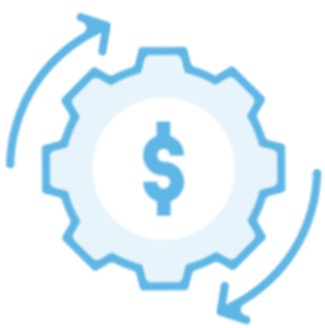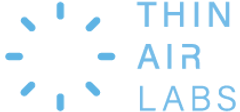What if we could write a new story for Alberta? A story that respects and builds upon the entrepreneurial spirit that put this province on the global radar. Alberta was built by mavericks and now new mavericks are championing innovation and designing a new way forward. This new way will create an economy that works for all of us, for our planet and for future generations.
Here’s my conversation with our Managing Partner, James Lochrie who I like to think of as a new kind of maverick - an entrepreneur and investor who knows that our future is a shared one, where we build companies as part of ecosystems and where collaboration drives what’s next.
LS: What is the philosophy behind Thin Air Capital?
JL: For me the ‘why’ is we are building businesses. People can think of investment from the standpoint of return on investment or social impact but for me, I’m an entrepreneur, I like building businesses. I like seeing things go from small to big. I like seeing the impact it has on people. So that’s the underlying philosophy….taking small ideas and turning them into massively impactful businesses across a global scale.
Investment is just one part of building a business, there are a lot of other responsibilities. We ensure that entrepreneurs are going to be successful in their own future and growth. For example, we help ventures find the right talent by supporting InceptionU. InceptionU re-skills workers for a technological future, allowing our ventures to find the talent they need for their company to succeed. We also support our ventures by doing community and ecosystem development. When we nurture partnerships with the universities, health services or established companies like Westjet we help our ventures find the connections necessary to scale.
I remember, it’s a really lonely job trying to figure out how to grow a small company into a big one. So, if we can build some of those bridges for our entrepreneurs and they can simply walk across them, they’ll accelerate much quicker.
LS: What do you mean by impact?
JL: TrueAngle recently launched their product to the market. When I made that investment I thought about all the people who could benefit from the swallowing device they make. These patients have had strokes, head and neck cancers and other injuries that prevent them from swallowing or speaking properly. Fixing this problem is extremely difficult. It requires seeing the right physical therapist in a hospital setting and using an enormous device that offers no feedback to the patient. TrueAngle miniaturized a massive physical therapy device, tied it into the patients’ cell phone, allowing them to do the therapy at home and remotely connect with their doctor who can track their progress. This device is so significant to these patients and makes their treatments so much more manageable and scaledable, it changes their lives. It’s that kind of impact I’m interested in.
LS: How does regeneration play into this?
JL: I like to see full cycle types of things happen. Symend is not obviously a regenerative company, but in fact it is, because it addresses inequality. When you think of the people impacted by the tools that Symend builds, they’re in most cases economically challenged, with a language barrier and dealing with multiple late payments. If Symend is resolving those issues in a more humane way, is it regenerative? Yes. But it’s a long-term play. If you think of regeneration in the fintech or healthtech sectors, it’s a lot more nuanced. We ask the question...what seeds are these ventures planting that will allow more people to participate in the economy and create more opportunity for everyone?
LS: What is Thin Air Capital’s investment thesis?
JL: 1 - The founder-first principle. Founders are special and entrepreneurs are uniquely capable of influencing the success of their ventures. They are missionaries not mercenaries. Supporting the entrepreneur’s success is the most important guiding principle of our investment thesis because the entrepreneur is the leader of the organization that’s going to make changes in the world.
2 - The return on the investment is driven by the size of the impact on humans. When we think about market size, we think about it in terms of how many humans are going to be impacted significantly enough to drive economic value. So the more humans impacted, the larger and more meaningful the potential return on investment can be. We actually believe it’s risky not to invest in companies that deliver human impact. There’s a fundamental investment risk mitigation process that focuses on problems human in nature and on a large scale.
LS: What stage are you looking at specifically?
JL: We have our advantage in the earliest stages of companies. Especially right now in the marketplace in Calgary, there are just not a lot of entrepreneurs with the experience or skill set to take their company from an idea and scale it all the way up to significant investment and growth. It’s simply because there haven’t been enough people or organizations that have done this in Calgary, so there’s a gap in the marketplace. When we think of where we can have the most influence, we know it’s at the earliest stages. Getting certain things right early on, allows for more success more quickly as companies progress. So, our focus is on pre-series A. This focus is grounded on a few factors:
- That’s where you make the best returns. You see massive multiples off of successful companies if you invest in the very first round of investment, so we’re looking for massive returns of 100x on our investments when we’re making them and that requires us to go in early.
- We then have to help the entrepreneur be successful as they go from an idea or early prototype out to an institutional round of investment.
This is where the Thin Air Design team comes into play. Every entrepreneur is going to come with their own strengths and weaknesses. Some entrepreneurs will come with the ability to create these amazing products, or raise capital, or do sales and marketing really well - but 100 percent will have gaps in some area of their competencies. These gaps are largely because their teams are too small or too inexperienced at these types of challenges. Thin Air Labs can put money to work at the idea stage or prototype stage without the validation of the market because we’re going to help the entrepreneur validate that market. We also have the Thin Air Community team that connects entrepreneurs with the people they need to know to come up with the solutions they’re looking for. Thin Air Community supports entrepreneurs in sector ecosystems to build trust and collaboration and drive innovation.
Our ability to help the entrepreneur at this early stage is where Thin Air Labs is really unique. Essentially we’re protecting our investment at this stage and
we’re trying to see if that investment can be grown through that injection of design and community all the way through to a series A and beyond.
LS: What do you want investors to understand about investing in pre-seed stage companies in Alberta?
JL: We’re in an economic crisis in Calgary, Alberta. The status quo is no longer acceptable. But we have an opportunity to seed the next generation of companies in Calgary and beyond. When I look back on the Alberta economy, it went from a largely unknown agricultural base and evolved to add energy which allowed Calgary to rise in the ranks among global cities. The growth was amazing both socially and economically, but that growth is waning and we need what’s next. The ‘what’s next’ is innovation. We’ve already proven that innovation can have a massive impact on certain sectors of our economy. So, we just need to grow an order of magnitude over the next 5 years and another order of magnitude over the following 10. If we do that, I believe we’re going to be successful. So that’s one aspect of why we should be investing, as citizens we should be supporting our own backyard.
The second thing about investing in the earliest stages of companies is that it’s incredibly risky. It is the hardest investment to make successful and it's why people tend to avoid this sector at this stage, including venture funds. They typically wait until a company gets to about one million dollars in revenue before they even pay attention to them and it’s simply because there’s so much risk before that.
The final point I’ll make on investing at this early stage is it’s the same as every other type of investing, you have to think of it as investing in a portfolio. If you’re going to invest in a single early-stage startup, you’re almost certainly going to lose your money. If you invest in a broader group of ventures, you have a much, much higher chance of a return on investment. It’s basic portfolio theory about how you disperse your money and disperse risk.
When I think of Thin Air Labs, I believe we’re special in the market. There’s nobody really doing what we’re doing in Canada. The results we’ve proven are very significant. When investors invest at the stages we invest in, we normally see a lot of companies peter out and die within a year to 18 months of that initial investment. We have had exactly zero deaths of our companies and we’ve seen significant follow on capital come into them. So as an investor, I have a lot of confidence that our model is going to work.
.png)


